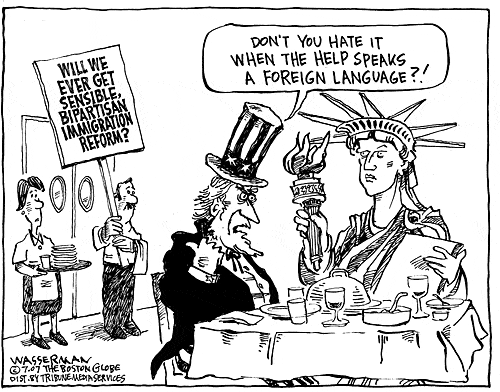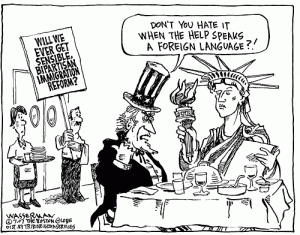On Monday, January 28, a bipartisan group of eight senators introduced an outline for comprehensive immigration reform, calling for a “tough but fair path to citizenship,” reform of the legal immigration system, effective workplace verification, and an improved process for admitting future workers. Obama is on board as well and, in a speech on January 29, announced his own policy push for immigration, calling for “immediate action” to overhaul the system and provide a clear path to citizenship for the estimated 11 million undocumented immigrants currently living in the U.S.
If the bill is passed, undocumented workers will be given legal, although provisional, status to live and work in the U.S., after which they will be eligible to apply for permanent citizenship over the course of ten years. The road to citizenship is, however, contingent on “securing the borders,” including measures such as adding more drones and other technologies to border surveillance, increasing Border Patrol staff, and completing a comprehensive entry-exit system at ports and border checkpoints.
The proposed immigration reform is quickly gaining momentum, with widespread public support and increasing bipartisan cooperation. A Public Policy Poll taken earlier this week found that 64 percent of Americans favor immigration reform that includes a path to citizenship. Also, Republican senators who previously opposed immigration reform, such as John McCain (R-Arizona) and John Boehner (R-Ohio), have signaled a willingness to cooperate with Democrats on the issue, causing many to call this immigration’s “big moment.”
Advocates, however, are cautious to rejoice too soon. The U.S. has a checkered and, ultimately, disappointing history of immigration legislation. The last time Washington took a swing at comprehensive reform in 2007, George W. Bush famously said, “I’ll see you at the bill-signing,” only to see the bill fail at the hands of conservative hardliners within his own party. Additionally, the failure of the 1986 Immigration Reform and Control Act (IRCA) serves as a cautionary tale. The IRCA, which granted amnesty to nearly 3 million undocumented immigrants, was believed to be the solution to America’s illegal immigration woes. But by failing to address the future flow of immigrants and other structural flaws, the IRCA actually contributed to worsening the situation, as shown by the 11 million undocumented immigrants in the U.S. today.
One thing is for certain: if this round of immigration reform is going to succeed, lawmakers need to learn from past mistakes. As shown in the case of the IRCA, failing to address the future flow of immigrants is problematic. The solution? The inclusion of a comprehensive guest-worker program.
The senators state in their outline that “to prevent future waves of illegal immigration a humane and effective system needs to be created for these immigrant workers to enter the country and find employment without seeking the aid of human traffickers or drug cartels,” but avoid specifically using the term “guest-worker program.” This isn’t surprising, as the guest-worker program is a historically contentious point within immigration debates. Providing a path to American citizenship for millions of illegal immigrants is, remarkably, less controversial than giving temporary guest-work visas to a few hundred thousand. Labor unions are opposed to such programs, arguing that they lower wages and conditions for U.S. workers, and many Americans fear that a guest-worker program for foreigners would increase competition in an already job-scarce economy. As a result, lawmakers find it a politically tricky terrain to navigate and avoid when possible.
However, it’s a terrain that needs to be dealt with. According to Michael Clemens, a senior fellow at the Center for Global Development, a guest-worker program is “absolutely far and away the biggest determinant of the unauthorized immigrant population a few years from now.” When the “Bracero” program ended in the 1960s, which had allowed Mexican migrants to take temporary agricultural work in the U.S., many of the workers remained in the U.S. illegally, knowing that if they returned to Mexico, they would be unable to return. Additionally, the demand for agricultural work remained and illegal immigration over the border continued. In order to avoid mistakes of the past, an effective immigration reform, today, demands the inclusion of a guest-worker program. Providing temporary work-visas to immigrants for employment, in fields such as farming and high-tech engineering, would curb illegal entries and also have a positive economic impact on U.S. society.
Although the U.S. currently has several guest-worker programs, they are separate, inefficient, and do not address low-skill labor. Lawmakers should take note from other countries, like Canada, who has a seasonal guest-worker program that brings over 20,000 workers to the country each year. Australia has one, as well, which began four years ago and will bring 1,600 workers to the country this year. New Zealand’s guest-worker partnership with Pacific Island countries is also highly regarded. Each has low illegal overstay rates, which suggests a similar program could in the U.S., albeit on a larger scale.
With the inclusion of a guest-worker program and continued bipartisan cooperation, the current attempt at a comprehensive immigration reform may be the one that finally sticks.


